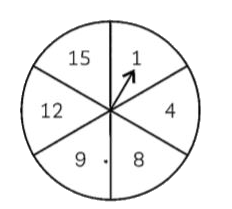In a single throw of a die, what is the probabilityy of getting a number greater than or equal to 4?
12
13
23
14
The correct Answer is:A
To find the probability of getting a number greater than or equal to 4 in a single throw of a die, we can follow these steps:
1. Identify the Total Number of Outcomes:
- A standard die has 6 faces, numbered from 1 to 6. Therefore, the total number of outcomes when throwing a die is 6.
- Total Outcomes = {1, 2, 3, 4, 5, 6}
2. Identify the Favorable Outcomes:
- We need to find the outcomes that are greater than or equal to 4. The numbers that satisfy this condition are 4, 5, and 6.
- Favorable Outcomes = {4, 5, 6}
- The number of favorable outcomes is 3.
3. Calculate the Probability:
- Probability is calculated using the formula:
Probability=Number of Favorable OutcomesTotal Number of Outcomes
- Substituting the values we found:
Probability=36
4. Simplify the Probability:
- Simplifying 36 gives us:
36=12
5. Conclusion:
- Therefore, the probability of getting a number greater than or equal to 4 in a single throw of a die is 12.
Final Answer:
The probability of getting a number greater than or equal to 4 is 12.
---
- A standard die has 6 faces, numbered from 1 to 6. Therefore, the total number of outcomes when throwing a die is 6.
- Total Outcomes = {1, 2, 3, 4, 5, 6}
- We need to find the outcomes that are greater than or equal to 4. The numbers that satisfy this condition are 4, 5, and 6.
- Favorable Outcomes = {4, 5, 6}
- The number of favorable outcomes is 3.
- Probability is calculated using the formula:
Probability=Number of Favorable OutcomesTotal Number of Outcomes
- Substituting the values we found:
Probability=36
- Simplifying 36 gives us:
36=12
- Therefore, the probability of getting a number greater than or equal to 4 in a single throw of a die is 12.
The probability of getting a number greater than or equal to 4 is 12.
Topper's Solved these Questions
- PROBABILITYBOOK - MCGROW HILL PUBLICATIONCHAPTER - PROBABILITYEXERCISE - MULTIPLE CHOICE QUESTIONS
20 Videos
- MOCK TEST - IBOOK - MCGROW HILL PUBLICATIONCHAPTER - MOCK TEST - IEXERCISE - MAT
60 Videos
- PROBLEMS ON CLOCKSBOOK - MCGROW HILL PUBLICATIONCHAPTER - PROBLEMS ON CLOCKSEXERCISE - EXERCISE
20 Videos
Similar Questions
Knowledge Check
In a single throw of two dice, what is the probability of getting a total 13
A0B1C1336D2536By throwing a die once the probability of getting a number greater than 4 is :
A23B13C43DNone of these
In a single throw of a die, what is the probability of getting a number greater than 4? 12 (b) 13 (c) 23 (d) 14
View SolutionA die is thrown once. What is the probability of getting a number greater than 4?
View Solution
What is the probability of getting a number greater than 5 on the spinner?
View SolutionIn a single throw of two dice what is the probability of obtaining a number greater than 7 , if 4 appears on the first dice?
View SolutionIn a single throw of a die, find the probability of getting a number :
(i) greater than 2 (ii) less than or equal to 2 (iii) not greater than 2.
View SolutionA die is thrown. Find the probability of getting: a number greater than or equal to 3
View Solution
